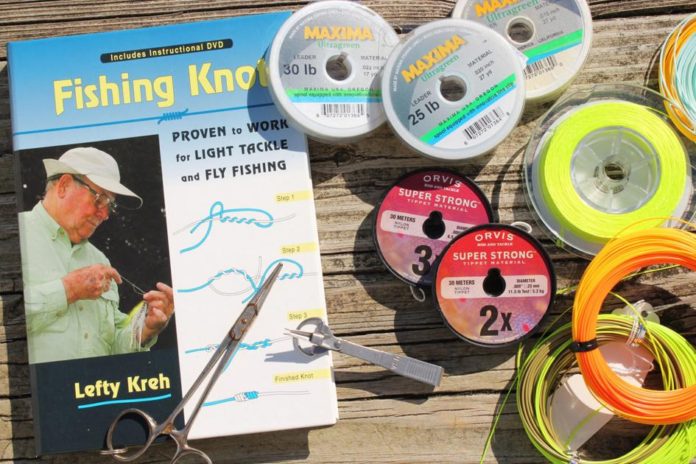Now is the best time to organize your fishing gear and replace worn out tackle and equipment in preparation of the opening of the Maryland trout season and the spring shad run. It is also a good time to practice your knot-tying skills and learn a few new knots to add to your fishing arsenal. A properly tied knot is key to fishing success.
Knowing how to tie a few basic fishing knots correctly is an essential skill that every angler needs to possess but most anglers would much rather be spending their time on the water catching fish than tying knots. Unfortunately, knots do take time to perfect. It is best to practice knot tying at home until you become a proficient knot tier. The objective is to spend less time tying and more time fishing.
One does not have to be an expert on every knot that can be used to catch a fish, but there are several essential knots a fly angler should practice until they become proficient. A fly angler needs to know at least one knot to connect terminal tackle, one line-to-line connection knot, and I don’t know how a fly angler could get by without the ability to tie a nail knot.
Basic knots
The Improved Clinch Knot is probably the most well-known and most used knot for attaching the monofilament fishing line to terminal tackle. It is easy to learn and is very reliable when tied properly. Other popular knots used for connecting terminal tackle are the Uni-Knot, the Palomar Knot and my favorite, the Pitzen Knot. The Pitzen Knot is a slip knot that requires less friction to firmly close, is very quick to tie and very strong.
It is important to close all knots firmly as a loose knot may slip and become untied or break. The heat created from the friction when a knot is pulled tight will weaken the knot. It is a good idea to moisten the knot prior to closing with a drop of water or saliva to allow the knot to close with less friction.
Line-to-line
In my opinion, the Blood Knot, sometimes referred to as a Barrel Knot, is the best knot for connecting two lines. The Blood Knot is a bit more difficult to learn and to tie proficiently but it is my choice for tying knotted leaders and adding a section of tippet to leader. Other line-to-line knots include the Surgeons Knot and the Albright Knot.
Nail Knot
The most reliable knot for connecting the butt section of the leader to the terminal end of a fly line is with a Nail Knot. As the name suggests, a nail can be used to make this important knot easier to tie. I use this knot to connect fly line backing to the beginning of a fly line as well. There is a tool made specifically for tying Nail Knots that I highly recommend. I have one attached to my fly vest at all times. The tool is called a Tie-Fast, manufactured by Sierra Stream & Mountain. You can order one at www.TIE-FAST.com. I suggest you order two in case you lose one.
How-to resources
I don’t have enough space in this column to provide step-by-step directions for my list of recommended knots. Fortunately, the Internet is a great source of “how-to-tie” fishing knot videos. When learning practical knots for both light tackle and fly fishing, I highly recommend learning form an expert. My go-to book on knots was written by the late fly fishing legend, Lefty Kreh — “Fishing Knots” (copyright 2007) published by Stackpole Books. The book offers Lefty’s advice on how to tie dozens of knots with plenty of tips garnered from over half a century of fishing experience in fresh and saltwater.
The book reads like a how-to manual in Lefty’s no-nonsense writing style with step-by-step instructions and includes a DVD. His tying tips for achieving maximum line strength and how to effectively connect lines of various diameters is good, practical information. His method of using a hemostat tool to tie a quick Clinch Knot is a great way to tie on a fly when your hands are cold and stiff, especially if your eyesight is not good and the light is fading.
In closing, I would like to offer my best personal advice when it comes to tying knots — “Never tie a knot quickly, especially if you are in a hurry.” For whatever reason, the need to retie a knot seems to happen when the fish are on the bite. The desire to quickly get the line back into the water often leads to a carelessly tied knot. Always test your knots by pulling firmly. Better to break while testing than when a fish is on the line. Tying better knots can make you a better angler, so take some time to improve your knot-tying skills.
Credit: Source link































